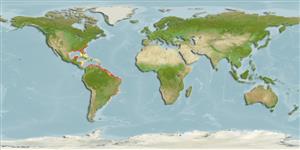Common names from other countries
>
Eupercaria/misc (Various families in series Eupercaria) >
Sciaenidae (Drums or croakers)
Etymology: Menticirrhus: Latin, mentum = beard, chin + Latin, cirrus = curly.
Environment: milieu / climate zone / depth range / distribution range
Écologie
marin; saumâtre démersal; océanodrome (Ref. 51243); profondeur 10 - ? m. Subtropical; 38°N - 33°S
Western Atlantic: Virginia, USA and the continental coast of the Gulf of Mexico to Rio Grande del Sur, Brazil.
Length at first maturity / Taille / Poids / Âge
Maturity: Lm 23.0, range 20 - ? cm
Max length : 48.3 cm TL mâle / non sexé; (Ref. 40637); common length : 30.0 cm TL mâle / non sexé; (Ref. 3702); poids max. publié: 1.4 kg (Ref. 40637)
Grayish brown above, shading to silvery below, no prominent bars. Lower jaw has single, stout, peg-like barbel with pore at tip. Scales on belly smaller than those on side (Ref. 26938).
Occurs usually in coastal waters over sandy and muddy bottoms; juveniles are abundant in the surf zone. Sometimes enters estuaries. Feeds mainly on worms and crustaceans. Excellent food fish (Ref. 26938).
Life cycle and mating behavior
Maturities | Reproduction | Spawnings | Egg(s) | Fecundities | Larves
Robins, C.R. and G.C. Ray, 1986. A field guide to Atlantic coast fishes of North America. Houghton Mifflin Company, Boston, U.S.A. 354 p. (Ref. 7251)
Statut dans la liste rouge de l'IUCN (Ref. 130435)
Can't connect to MySQL database (fbapp). Errorcode: Too many connections
